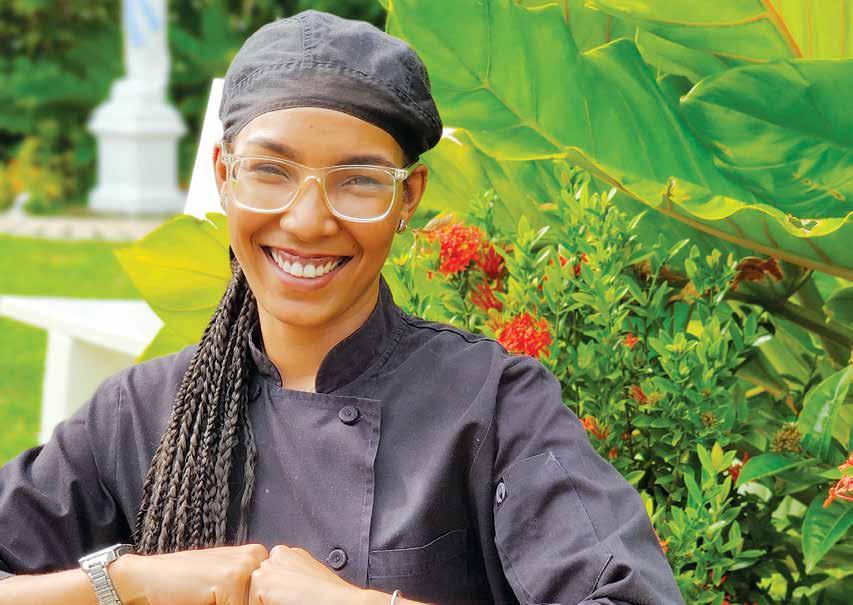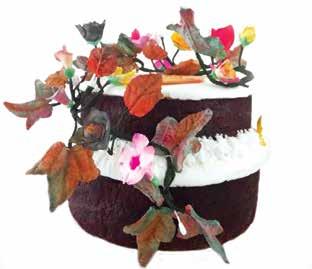
5 minute read
Memoirs of a celiac affected chef
Food is life, and that is so very true for people who have allergic reactions to some of the most common or popular things we normally enjoy. Nikita Riley, a chef who is gluten-intolerant, shares her perspective from someone on the other side of the kitchen. So foodies, if you are allergic to gluten, read on to find out things to flag when you eat out.
It was my birthday and I went to dine at one of the island’s prestigious local restaurants to celebrate. I had looked forward to this moment for months since the restaurant introduced wonderful gluten-free options to their fine dining menu. I was having a nostalgic feeling of royalty in my new stylish black dress, red heels and my tiara glistening in the full moonlight.
Perfectly seated in the restaurant overlooking the stunning ocean view, the fresh smell of the sea sprays influenced my menu choice to a sea food option. I chose shrimp Alfredo with Linguine gluten-free pasta and when it was presented at the table it gave off a mouthwatering aroma which rivalled one of my signature dishes.
Caught in the moment of the first taste I felt bliss and immediately thought nothing should spoil this exquisite moment. Or so I thought. Fifteen minutes after consuming the meal I started to experience excruciating abdominal pains and feelings of nausea. My stomach became extremely bloated to the extent I could have passed for a fourmonth pregnant woman. It was then I realised the meal was not entirely gluten-free. What exactly went wrong?
As the awareness of celiac disease grows, more restaurants across the island are offering gluten-free options on their menu. However the question is, are they truly offering gluten-free options? Anytime persons suffering from celiac disease or any other form of gluten-intolerance sit
by Nikita Riley to have a meal, they all wish to feel safe and secure that what they are eating will not only be delicious, but will not cause any allergic reactions. Thus, restaurants/business owners

offering gluten-free options must focus on what may cause gluten contamination in the kitchen since the environment is equally important in determining how gluten-free safe your surroundings are.
Gluten-free stations should be designated in kitchens to prevent cross contamination. Kitchens and equipment used to prepare gluten-free foods should be thoroughly cleaned. Also, all gluten products such as wheat flours, breads and crackers should be safely stored in a sealed place separate from gluten-free foods since minute particles of these products may at times become airborne. Such gluten foods should be prepared in a separate environment from the gluten-free kitchen.
Chefs may consider changing clothing, washing the face, neck, forearms and hands before preparing gluten-free foods after leaving a gluten environment such as the pastry room. Gluten-free foods should not be baked, fried, seared or boiled in the same equipment as glutenous foods.
We as chefs must take the time to read product labels and also do ample background product research, especially if we are catering to glutenintolerant persons. In some cases, extra product knowledge such as reviewing regulations for what is considered gluten-free and a gluten-free environment may vary from country to country. Depending on the environment where a gluten-free food is produced, companies may have a high chance of cross contamination from other manufactured products which contain gluten in the same production plant.
Through my vast research into celiac disease and food preparation, I have found that when preparing foods, one must also take into account the effects of binders and enhancers to highly glutensensitive persons. Widely used commercial gluten-free products are made with gums as thickeners and binders such as xanthan gum and guar gum, which can cause side effects that mimic symptoms of celiac. It is safe to say despite the fact that many of these gums are proven to be safe and healthy, many gluten-sensitive persons will prefer not to use them to avoid added discomfort to their daily routines. Therefore, as gluten-free chefs, we must take the time to do adequate product research and make sure we read labels.
Although many in the culinary industry are aware of the term gluten-free, many are unaware of the term celiac disease and all the symptoms associated with it. Throughout my experience working in both hotels and restaurants, the term glutenfree was discussed casually and moderate action was taken to put policies in place for celiac diseased persons. As a result, many restaurants run the risk of offering what they can’t produce; however, I have found that there are some restaurants in Barbados which ‘cook what they preach’ and have met the necessary requirements to be deemed gluten-free.
While exploring the world of gluten-free cooking, I have found that through my research it has the potential to transform an ordinary chef into a food scientist. Furthermore, understanding the many varieties of flour options available has excited the culinary world with new flavours and textures streaming away from the common use of wheat flour. This knowledge creates a larger understanding of the science of food and forces chefs to be aware of how many new ways delicious foods can be hatched with the correct use of many natural ingredients and our vast imaginations.
Recipe Rich Gluten-free Black Cake This black cake recipe is an authentic inheritance of the traditional influence by Barbadian ancestry. The gluten-free component is a simple approach of substituting the original flour mixture with one of your favourite gluten-free cake flour blends.
Makes one 10-inch Black Cake 6 oz brown sugar 8 oz lb Glow Spread 4 eggs 10 oz EatGF gluten-free cake flour ½ tsp mixed essence ½ tsp Almond essence ¼ tsp nutmeg, clove, ginger, cinnamon, spice 2 tbsp browning 2½ lbs minced mixed fruit ½ tbsp baking powder ¼ tsp bicarbonate soda ½ tbsp Chunky Peanut Butter (add 1 tablespoon if desired) 3 oz blackcurrant jam or raspberry jam 1 tbsp molasses Begin as for a basic cake recipe. Sieve all dry ingredients including spices together and set aside. Cream butter, sugar then adding eggs and essence on low speed if using a stand mixer. Add the remaining wet ingredients and fruit mix, then flour mixture. Traditionally the flour mix is judged by placing a wooden spoon into the cake batter which should stand up without needed support before putting the batter into the cake pan. Bake at 300 degrees for one hour. Lower heat to 250- 275 for a further 2 ½ - 3 hours.










